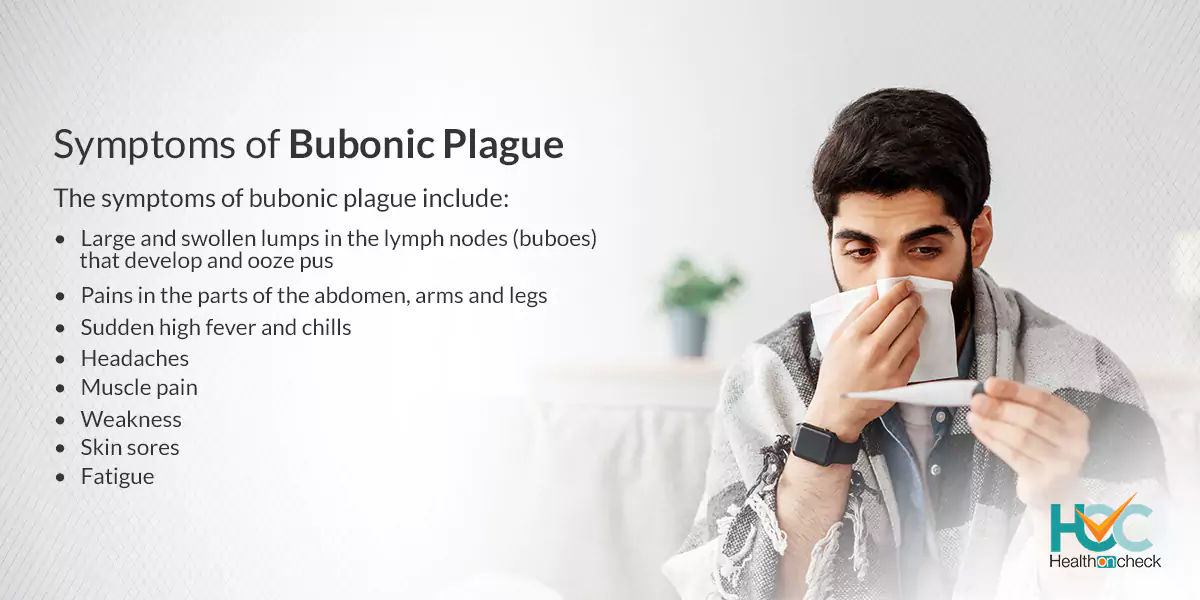What is Bubonic Plague?

Bubonic plague is one of three clinical types of plague, an infectious disease that is caused by the bacterium Yersinia pestis. The other two types of plagues are septicemic plague and pneumonic plague. Bubonic plague is the most commonly occurring form of plague, symptoms of which include the appearance of buboes—swollen, tender lymph nodes, usually found in the armpits and groin. The infection is mostly spread to humans through infected fleas travelling on rodents. It was called the Black Death in the Middle Ages where millions of people were killed because of it.
What are the Types of Bubonic Plague?
Bubonic plague is a type of plague and it got its name from the swollen lymph nodes (buboes) which occur because of disease. The nodes in the armpit, groin, and neck can become as big as medium-sized apples and can discharge pus.
The two other types of plague are:
– Septicemic plague
It occurs when the infection goes through the body.
– Pneumonic plague
It occurs when the lungs are infected.
What are the Symptoms of Bubonic Plague?
The symptoms of bubonic plague include:
– Sudden high fever and chills.
– Pains in the parts of the abdomen, arms and legs.
– Headaches.
– Large and swollen lumps in the lymph nodes (buboes) that develop and ooze pus.
– Fatigue.
– Weakness.
– Muscle pain.
– Skin sores.
What are the Causes of Bubonic Plague?
Bubonic plague is caused by the bacterium known as Yersinia pestis (Y. pestis) and it’s spread mostly by fleas on rodents and other animals. Humans who are bitten by fleas become infected and develop plague.
Animals, especially cats are vulnerable to plague and might get infected by eating sick rodents. These cats then pass plague-infected droplets to humans.
People mostly develop plague from when a flea carrying the bacterium Yersinia pestis bites them. The fleas usually come from pets or small wild animals.
People can also get infected by the plague through direct contact with tissues of a sick animal.
Plaque can also pass from animal to human and from human to human. Tiny droplets in the air can spread the bacteria when an infected person or animal coughs or sneezes and other people can be infected when they inhale the droplets. They can also get infected by touching coughed-up mucus.
What are the Risk Factors of Bubonic Plague?
The main risk factor of bubonic plague is a recent flea bite and exposure to rodents, particularly squirrels, rabbits, or prairie dogs, and bites or scratches from infected pets.
The other risk factors include:
-Location
Though plague has been reported in almost all parts of the world, it most commonly occurs in Madagascar, the Democratic Republic of Congo, and Peru. In fact, in Madagascar, there is a plague outbreak almost every year.
Plague is common where there are high populations of rodents and their fleas, especially in rural and semi-rural areas. It also occurs in places with overcrowding, poor sanitation, or huge rat populations.
– Jobs
People who work outdoors in areas where plague-carrying animals are common are at higher risk of getting plaque. People working in animal clinics in these areas also are at an increased risk of getting into contact with domesticated animals with the disease.
What are the Complications of Bubonic Plague?
The complications of bubonic plague might include:
– Gangrene
In tiny blood vessels of the fingers, toes, nose, and ears blood clots may form which can cause the tissues to die. The dead tissue is required to be removed.
– Meningitis
In some cases, the plaque may lead to swelling and disease of the protective tissues that surround the brain and spinal cord. This condition is known as meningitis.
– Pharyngeal plague
Rarely, the disease might be present in the tissues in the back side of the nasal cavity and mouth, known as the pharynx. This condition is called pharyngeal plague.
– Death
The risk of death in people with all types of plague is nearly 11%. People with bubonic plague survive with prompt diagnosis and treatment. Death is more likely with septicemic plague as it’s difficult to diagnose and worsens quickly.
How Bubonic Plague is Diagnosed?
Your doctor can diagnose the plague based on:
– Symptoms.
– Likely exposure to the disease because of visiting an area prone to plaque.
– Getting in contact with a dead or sick animal.
– Known flea bite or known exposure to rodents.
For diagnosing bubonic plague, your doctor will prescribe blood or tissue sample tests. The samples will be sent to the lab to check if Y. pestis is present.
What are the Treatment Options Available for Bubonic Plague?
Treatment for plague starts as soon as the doctor suspects the disease. Treatment is normally done in the hospital. Mainly antibiotics are given to treat bubonic plague. Antibiotics given to treat this disease usually include:
– Gentamicin.
– Doxycycline.
– Levofloxacin.
– Ciprofloxacin.
– Moxifloxacin.
– Chloramphenicol.
Living with Bubonic Plague
It might seem that bubonic plague is a thing of the past, but it still exists today in many parts of the world. The most competent way to prevent plague is to avoid the fleas that reside on rodents like rats, mice, and squirrels. The fleas can also live on domestic animals like cats. You need to protect your pets and yourself from fleas and the possible infections they might carry. The symptoms of plague normally develop two to six days after exposure. Recovery is best when you start treatment within 24 hours of getting the disease. You are most likely to feel better after one to two weeks. However, untreated bubonic plague can be life-threatening.
Whom to Consult?
If you develop symptoms of bubonic plague, including fever, pain, and swollen lymph nodes, you should immediately seek medical assistance. It is particularly true if you have been exposed to flea bites or had close contact with someone with bubonic plague. Consult with your doctor and get yourself diagnosed in such cases.





